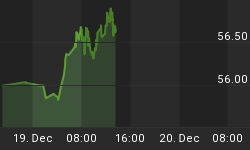America's massive trade deficit exerts pressure on the US dollar as currency is shoveled abroad in return for goods and services. As the economy is slowing down and possibly sliding into recession, the rate at which the trade deficit grows may be slowing down; in September, this deficit was "only" $64.3 billion - still near record territory, but not as bad as economists had predicted.
Does this mean the worst for the dollar is over? After all, it now costs over 50% more to pay for a €100 euro hotel room than six years ago, assuming the hotel has not raised its price. Can it get worse? Since you probably cannot afford to go to Europe on vacation anymore, it may not matter to you. But even if you do not travel abroad, it does matter to you as your purchasing power erodes; amongst others, the cost of imports and commodities, including the price you pay at the gas pump, is likely to go up.
The trade deficit is a component of the broader current account deficit, which also includes investment income. The current account deficit is the shortfall that needs to be covered by foreign investors for the dollar not to fall. Last year, foreigners needed to purchase $805 billion in US dollar denominated assets, just to keep the dollar from falling, that's more than $2 billion every single day.
As the US economy is slowing down, what matters is whether other factors propping up the dollar slow down even faster. The most apparent one is whether foreigners will be as inclined to invest in a slowing economy. Another is trade policy: a new Congress may take a tougher look at 'protecting' local jobs. If such policy is not engineered very carefully, the risk is high that it will hurt all those who have been able to adjust by taking on jobs working in an industry dependent on imports; the trade deficit makes the dollar vulnerable should our trading partners not agree with new rules or restrictions on trade.
Note, too, that we are talking about slowing growth in the deficit, not about reversing the trend, nor about eliminating an enormous cumulative deficit that has been built over time. We only need to have a negative change at the margin of any parameter that supports the dollar, for the dollar to weaken further.
The main reason the dollar has not fallen faster and more sharply is that it is in no one's interest for the dollar to fall. The most prominent recent example of the pain a weak dollar can cause is with Airbus, the European aircraft maker. It is an "old-economy" company with bureaucratic structures seemingly incapable of adjusting to a more rapidly changing world. Mistakes in today's world are expensive, and Airbus has had a number of major missteps. In addition to their internal problems, the weak dollar makes their operation operate at a significant loss. While many rightfully say Airbus is too 'important' to fail, it has the hallmarks of being yet another disastrous European project along the lines of the overly expensive Eurotunnel project that has created losses for multiple generations of investors (Eurotunnel is the railway under the North Sea connecting the UK with mainland Europe).
At least in Europe, the central bank (ECB) employs a strong dollar as one of its tools to exert pressure on European governments to induce reform. The pain of too strong a euro is shrugged off by ECB president Trichet who says that a 1 percentage drop in US growth only impacts European growth by 0.2%. However, in Asia, economies are hopelessly dependent on exports to the US and, in our assessment, will do anything in their power to keep their own inflated economies afloat. In plaintext, this means that Asian countries are likely to engage in competitive devaluation, leaving the euro as the de facto winner as pressures on the dollar mount. Gold and resource rich countries are also likely to continue to benefit from this environment. In our assessment, dollar cash is a risky, not a safe asset; investors may want to consider diversifying their portfolios to be prepared for a potential further deterioration of the dollar.
The next time you hear about the trade or current account deficit growing at a less brisk pace, evaluate why this deficit has gone down. Is it because of a shift in policies to induce consumers to save and invest? Or is it because the economy is slowing down? As consumers cannot afford to spend as much as in the past, their savings rate is bound to go up as well; but there is a difference between savings going up because consumers cannot afford to spend anymore, and an environment that fosters savings and investments. Given that most politicians are interested in short-term growth no matter what party they belong to, it remains to be seen whether the new Congress will pave the way for a change. Remember that we do not have an "ownership" society when all we own is debt.
We manage the Merk Hard Currency Fund, a fund that seeks to profit from a potential decline in the dollar. To learn more about the Fund, or to subscribe to our free newsletter, please visit www.merkfund.com.















